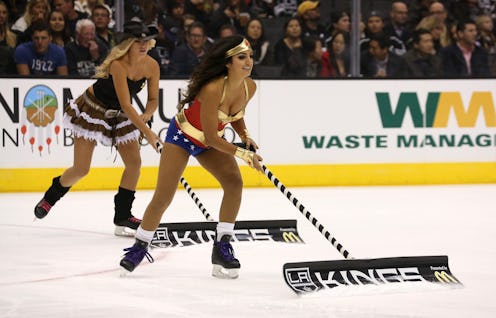News
These Women Are As Cold As They Look
Sexism in the workplace seems ubiquitous in every industry, and sports are no exception. From the Dallas Cowboys Cheerleaders to the Laker Girls, every NBA and all but six NFL teams has a group of underpaid, overworked women whose depend more on looking good in a bikini (think jiggle tests) than encouraging their teams. A recent piece in Mother Jones by Julia Lurie exposes the horrifying conditions of NHL's hardworking "ice girls," the NHL's answer to the NBA and NFL's cheerleaders.
Ice girls play a considerable role in hockey games — they clear the ice during breaks in the game. This is an undeniably essential job during hockey games, and all teams are required to have maintenance individuals to shovel away the slush buildup in high-traffic areas of the ice. And while half of the teams in the NHL have fully-clad, warmly dressed men or women to fulfill this job, the other 50 percent use "ice girls," described by one fan to the Wall Street Journal as "cheerleaders with a purpose."
And while they certainly have purpose, it remains unclear as to why they must do their jobs while wearing next to nothing in the freezing temperatures of a hockey arena. While shoveling the ice was generally a quick run that didn't leave the ice girls too cold, there were other situations in which their inability to don a jacket became extremely problematic.
A former Los Angeles Kings' ice girl told Lurie that whenever the ice girls were "on the ice," "performing," "or schmoozing in public," women were not allowed to put a jacket on. It did not matter what the temperatures were, whether the women were indoors or outdoors, or how long they were there — if there were people to be greeted or entertained, jackets stayed off.
One ice girl remembers, "It was 20 degrees and we were in shorts, with two pairs of stockings," and sometimes these conditions lasted for up to nine hours. She continued, "It really felt like we were in some kind of torture camp."
Temperature aside, there were other instances of blatant sexism? mistreatment? general unfairness? that plagued the lives of these ice girls. For example, Kings' ice girls were prohibited from ever eating in uniform, because apparently, real women don't eat. The women were also required to leave any restaurant, mall, or other public area if a player happened to be in the same place, regardless of who was there first. As one Kings' ice girl noted, they were at "the bottom of the totem pole."
So concerned were the ice girls about preventing any fraternization with players that they would always have a lookout in the group to ensure that the women and the male players were never in the same place at the same time. Said one former ice girl to Lurie:
There was always someone who was on alert, making sure the coast was clear. If a player walked into the restaurant, we had to put it in a to-go container.
Wages are another a major issue for both ice girls and other sports' cheerleaders. In the past few months, several lawsuits have emerged from cheerleaders in the NFL who have claimed mistreatment and wage theft from teams like the Buffalo Bills and the Oakland Raiders. Other teams' cheerleaders have filed similar suits arguing that they should be paid more, and it is no secret that the superficially glamorous life of a cheerleader does not come with many perks. Oakland Raiderettes earn a mere $125 per game, which over the course of 16 regular season games and four preseason games, works out to $2500. For comparison, the Oakland Raiders mascot makes $40,000, or $2,500 per game.
And while NFL cheerleaders are more than justified in their outrage, the NHL ice girls' wages are even more shockingly low. On the higher end were the women who made $15 an hour for 10 to 30 hours a week, amounting to anywhere from $150 to $450 a week. But many of these ice girls were required to do their own makeup and styling, with some reporting that they spent up to $350 a month on cosmetics every month to ensure that they were always camera ready.
For those who were lucky enough to have professional stylists, the tradeoff came in their pay — only $50 a game, less than half of the already low wages of an Oakland Raiderette.
Despite these conditions, some ice girls told Mother Jones that they enjoyed their experiences. Some of their peers, on the other hand, couldn't get out fast enough. Either way, one thing is clear — the women of sporting events are not getting their dues, and something about that needs to change.
